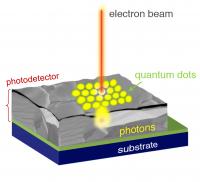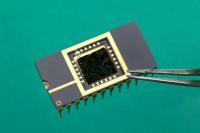Science
NASA's 2013 HS3 Hurricane Mission to Delve into Saharan Dust

A well-defined plume of dust swept across the entire Atlantic Ocean on June 24, 2009. In this photo-like image taken by the Moderate Resolution Imaging Spectroradiometer (MODIS) on NASA’s Aqua satellite in three consecutive overpasses, the dust stretches from its origins in Africa’s Sahara Desert to the Lesser Antilles Islands on the eastern edge of the Caribbean Sea. Such spectacular dust storms are not uncommon.
1.NASA's Goddard Space Flight Center 2.此則是否有版權問題 原址:
- Read more
- 383 reads
Iranian Scientists Produce Dynamometer for Nanoparticles, Biocells
The use of optical tweezers in order to measure the force in objects at nanometirc scale can be an interesting idea for the researchers in all fields, including biosciences. The use of the optical tweezers requires a comprehensive and exact understanding of its potential.
- Read more
- 326 reads
U.S. Berkeley Lab Team Uncovers Secrets of Biological Soil Crusts
They lie dormant for years, but at the first sign of favorable conditions they awaken. This sounds like the tagline for a science fiction movie, but it describes the amazing life-cycles of microbial organisms that form the biological soil crusts (BSCs) of Earth's deserts. Now a research team with the U.S. Department of Energy (DOE)'s Lawrence Berkeley National Laboratory (Berkeley Lab) has reported a unique molecular-level analysis of a BSC cyanobacterium responding to the wetting and drying of its environment. The results hold implications for land management, improved climate change models, and a better understanding of carbon cycling in soil microbial communities and how changes in global temperatures impact Earth's deserts.
- Read more
- 318 reads
NASA's Webb Telescope's Last Backbone Component Completed
Assembly of the backbone of NASA's James Webb Space Telescope, the primary mirror backplane support structure, is a step closer to completion with the recent addition of the backplane support frame, a fixture that will be used to connect all the pieces of the telescope together.
- Read more
- 460 reads
Warm Ocean Causing Most Antarctic Ice Shelf Mass Loss

This photo shows the ice front of Venable Ice Shelf, West Antarctica, in October 2008. It is an example of a small-size ice shelf that is a large melt water producer. The image was taken onboard the Chilean Navy P3 aircraft during the NASA/Centro de Estudios Cientificos, Chile campaign of Fall 2008 in Antarctica.
- Read more
- 388 reads
Mars Water-Ice Clouds Are Key to Odd Thermal Rhythm

This graphic depicts the Mars Climate Sounder instrument on NASA's Mars Reconnaissance Orbiter measuring the temperature of a cross section of the Martian atmosphere as the orbiter passes above the south polar region.
- Read more
- 361 reads
M31: Black Hole Bonanza Turns up in Galaxy Next Door

- Twenty-six black hole candidates have been identified in Andromeda, aka M31, adding to 9 previously found.
- This is the largest number of possible black holes to date ever found in a galaxy outside of our own Milky Way.
- These are stellar-mass black holes, which are formed by the collapse of a giant star and have masses between five and 10 times the Sun's.
- Researchers used over 150 separate Chandra observations spread over 13 years to obtain these results.
- Read more
- 396 reads
New quantum dot technique combines best of optical and electron microscopy

Much like in an old tube television where a beam of electrons moves over a phosphor screen to create images, the new microscopy technique works by scanning a beam of electrons over a sample that has been coated with specially engineered quantum dots. The dots absorb the energy and emit it as visible light that interacts with the sample at close range. The scattered photons are collected using a similarly closely placed photodetector (not depicted), allowing an image to be constructed.
- Read more
- 346 reads
An ultrasensitive molybdenum-based image sensor: New material can result in 5 times more sensitive cameras

This prototype is the first ever molybdenum based image sensor, 5 times more sensitive than current silicium-based technology.
- Read more
- 369 reads
Human Rights
Fostering a More Humane World: The 28th Eurasian Economic Summi

Conscience, Hope, and Action: Keys to Global Peace and Sustainability

Ringing FOWPAL’s Peace Bell for the World:Nobel Peace Prize Laureates’ Visions and Actions

Protecting the World’s Cultural Diversity for a Sustainable Future

Puppet Show I International Friendship Day 2020


